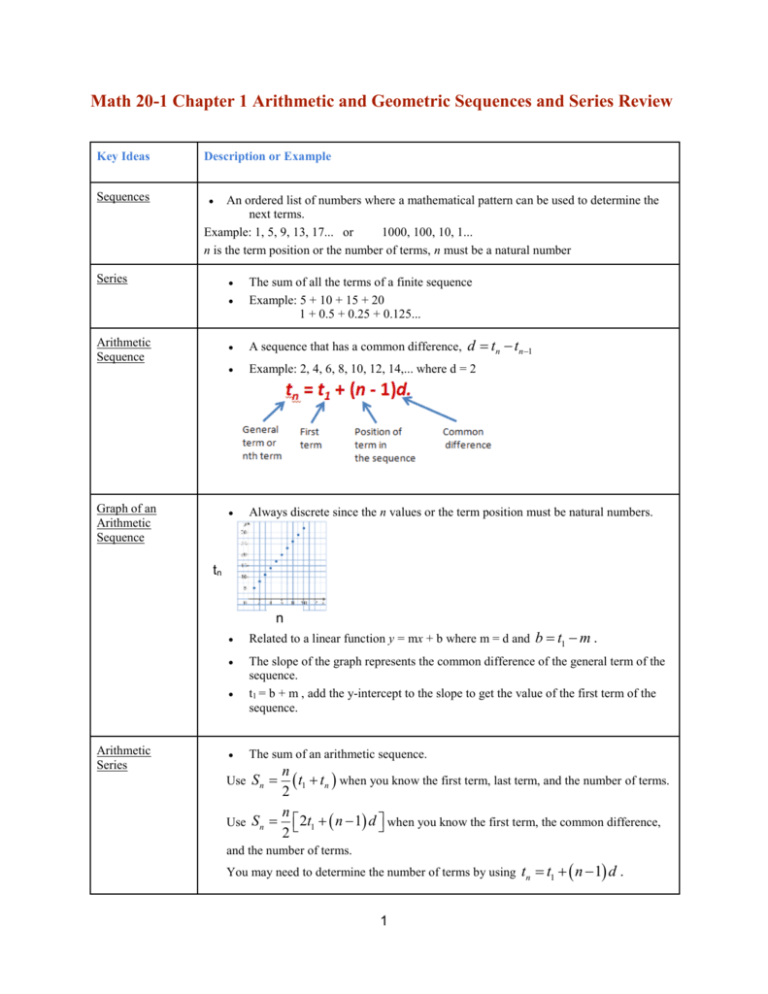Ch 1 Concept Review
advertisement

Math 20-1 Chapter 1 Arithmetic and Geometric Sequences and Series Review Key Ideas Description or Example Sequences ● An ordered list of numbers where a mathematical pattern can be used to determine the ● ● next terms. Example: 1, 5, 9, 13, 17... or 1000, 100, 10, 1... n is the term position or the number of terms, n must be a natural number ● The sum of all the terms of a finite sequence ● Example: 5 + 10 + 15 + 20 Series 1 + 0.5 + 0.25 + 0.125... Arithmetic Sequence ● A sequence that has a common difference, d tn tn1 Graph of an Arithmetic Sequence ● Always discrete since the n values or the term position must be natural numbers. ● Example: 2, 4, 6, 8, 10, 12, 14,... where d = 2 tn n ● Related to a linear function y = mx + b where m = d and b t1 m . ● The slope of the graph represents the common difference of the general term of the ● Arithmetic Series sequence. t1 = b + m , add the y-intercept to the slope to get the value of the first term of the sequence. ● The sum of an arithmetic sequence. n t1 tn when you know the first term, last term, and the number of terms. 2 n Use S n 2t1 n 1 d when you know the first term, the common difference, 2 Use S n and the number of terms. You may need to determine the number of terms by using 1 tn t1 n 1 d . Geometric Sequence ● A sequence that has a common ratio. tn t1r n 1 ● Example: 3, 9, 27, 82, 243, 729, 2187... where r = 3 Graph is discrete, not continuous, and not linear. Problem Finite Geometric Series A finite geometric series is the expression for the sum of the terms of a finite geometric sequence. The General formula for the Sum of the first n terms Sn t1 (r n 1) ,r 1 r 1 Sn Known Values are: t1, r and n rtn t1 ,r 1 r 1 Known Values are: t 1, r and tn Problem 2 Infinite Geometric Series A geometric series that does not end or have a final term. It may be convergent (sum approaches a value, there is a formula for this) or divergent (sum gets infinitely larger). The series is convergent if the absolute value of r is a fraction or decimal less than one: |r|<1 , -1 < r < 1 The series is divergent if the absolute value of r is greater than one |r|>1, -1 > r > 1 Sum of an Infinite Geometric Series, only if it converges You must know the value of the first term and the common ratio. General or explicit formula ● The unique parameters are substituted into the formula. ● The parameters are t1 and r for a geometric sequence or d for arithmetic sequence. S t1 , r 1 1 r ● Example: tn 3 2 n 1 or tn 2n 3 Vocabulary Definition Common Difference occurs in an arithmetic sequence or series ● The difference between successive terms in an arithmetic sequence, which may Common Ratio occurs in a geometric sequence or series ● The ratio of successive terms in a geometric sequence, which may be positive be positive or negative. ● Formula: or negative. ● Formula: Finite Sequence ● A sequence that ends and has a final term. Divergent ● Where the sum of the infinite geometric series continues to grow and not approach a finite number. There is no sum. ● When |r|>1, 1 r 1 Convergent ● Where the sum of the infinite geometric series approaches a finite number. ● There is a sum. When |r|<1, 1 r 1 3 Common Errors Formulas Description ● Using the wrong formula such as using the general term formula instead of the sum formula for a series. Sequences and Series ● Confusing sequences with series. Sequences are the list of all the terms where series are the sum of all the terms. Divergent or Convergent Discrete or Continuous ● Must know the difference The n value refers to the number of terms or a specific term. The value of n must be a natural number making the graph of the sequence discrete. 4








